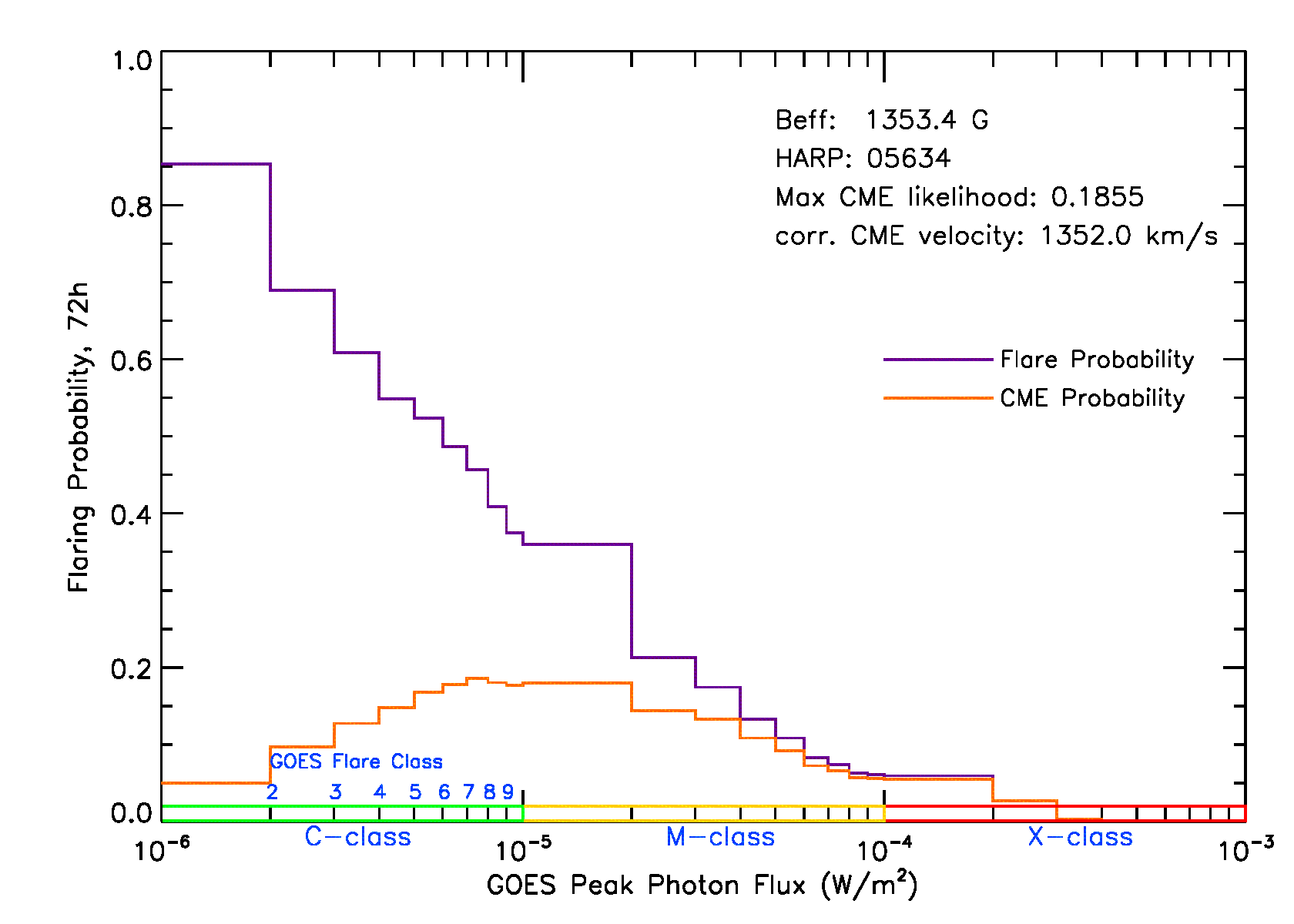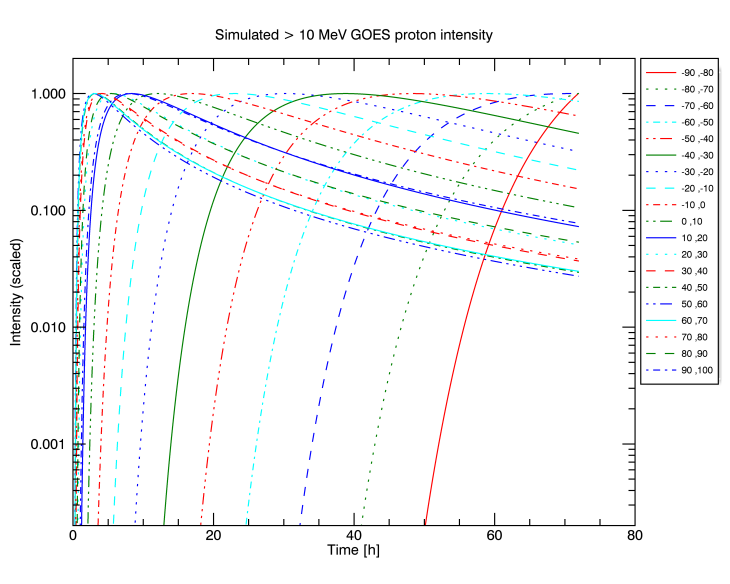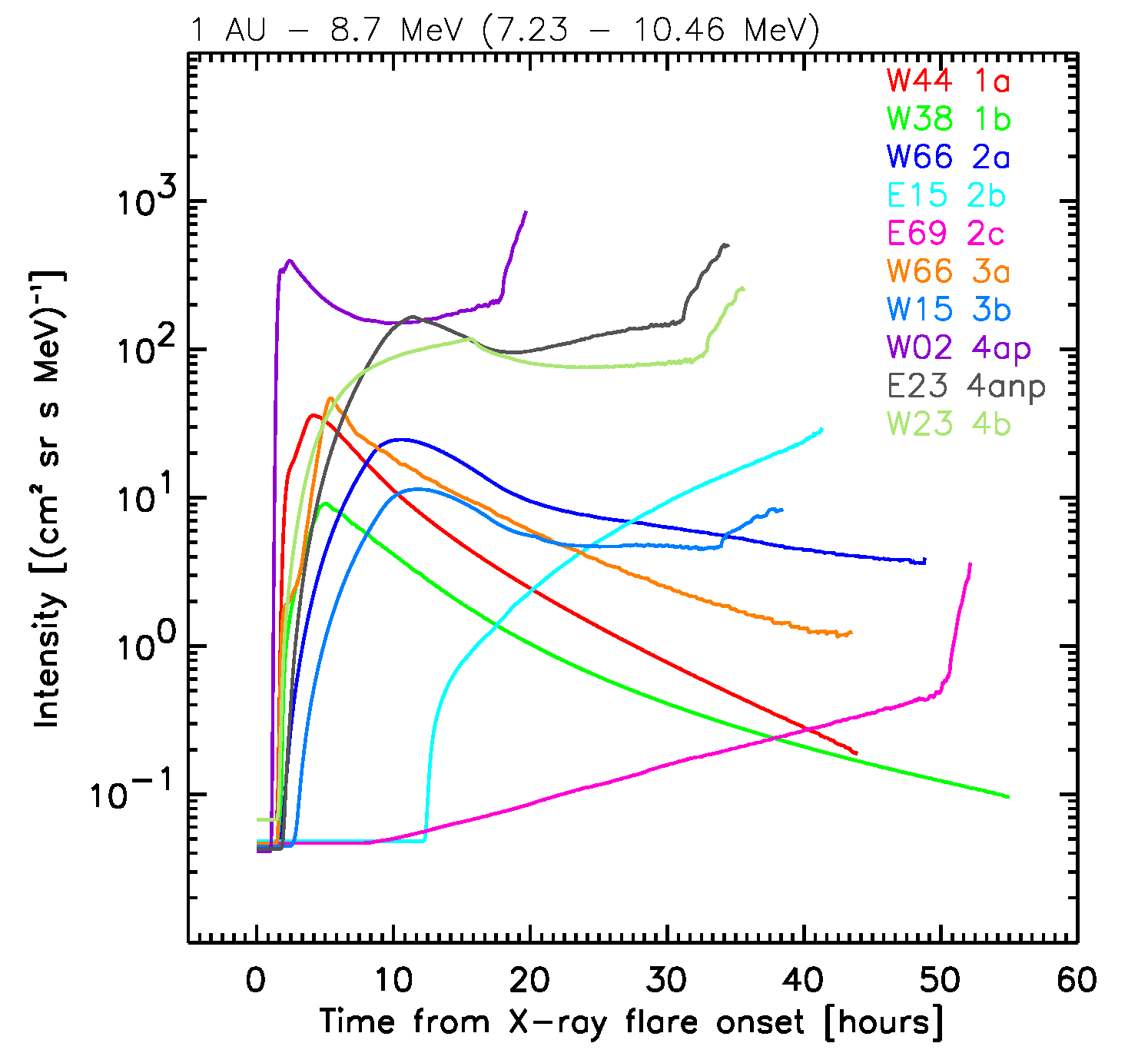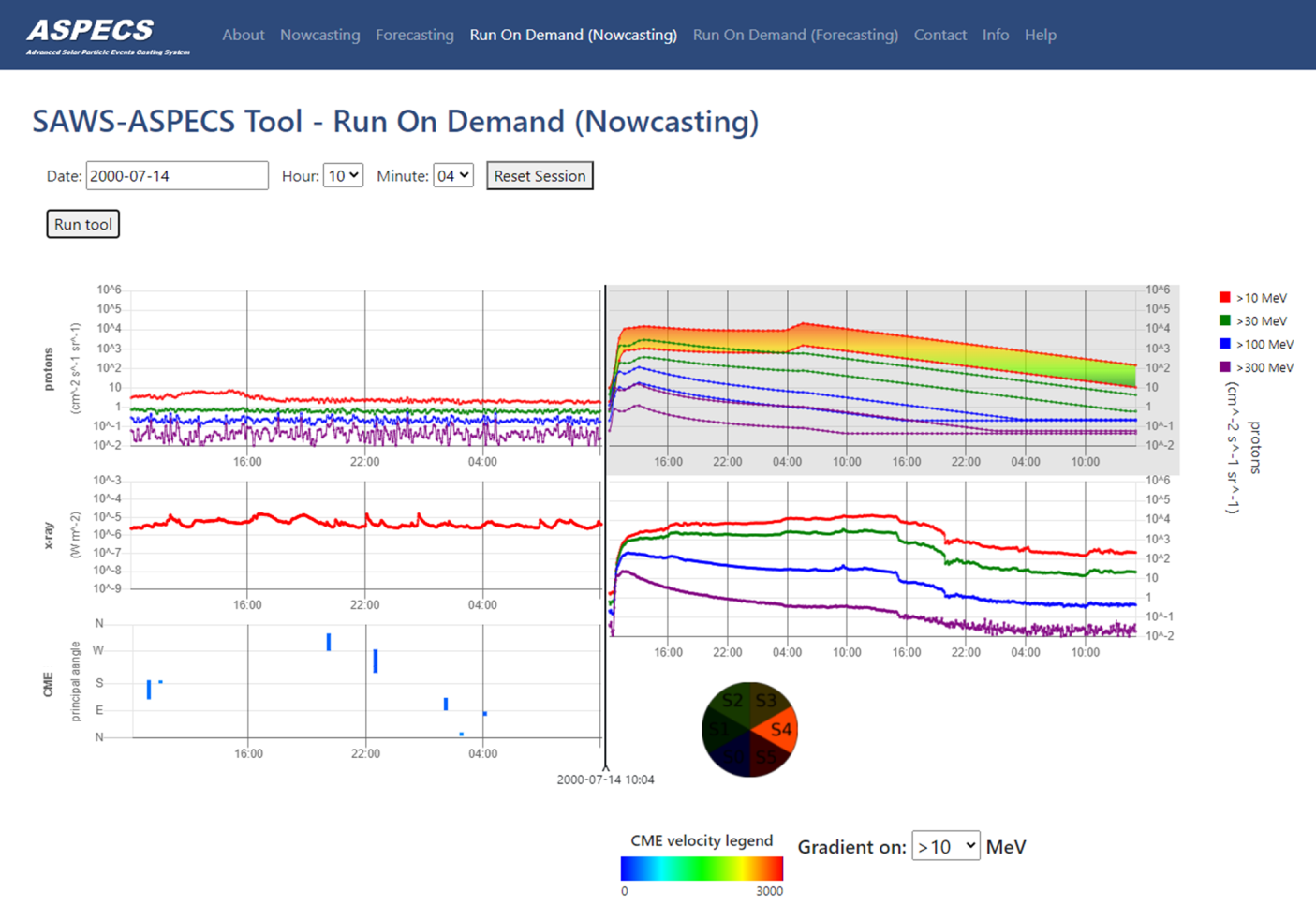SAWS-ASPECS Tool - About
Introduction
The Advanced Solar Particle Events Casting System (ASPECS) is a modular operational tool that collates and combines outputs from different modules providing predictions of solar phenomena (i.e. solar flare and coronal mass ejection (CME) likelihood of occurrence), solar energetic particle (SEP) event occurrence, expected peak flux and SEP time profile – all of which evolve with time. This is achieved by a 3-tier system. The predictions start with the solar flare forecasting based on near real-time Space‐Weather HMI‐Active Region Patch (SHARP) outputs and continuously evolve through updates based on near-real time inputs (e.g. solar flare and CME data/characteristics) received by the system. Finally, for the first time the complete time profile of the SEP event at respective energies is provided in near real-time, utilizing both simulations and observations. The Figure below provides a schematic representation of the ASPECS’s set up.

Short Description of the tool
ASPECS incorporates two modes of operation. The forecasting and the nowcasting. The forecasting mode is the pre-event one, meaning that no event has actually taken place on the Sun, yet. The only input is the identification of an active region (AR). The nowcasting mode is the post-event mode. In this case a solar flare, a CME or a combination of both have taken place.
Forecasting mode
The input used is the SHARP output from the processing of the Solar Dynamics Observatory (SDO)/Helioseismic and Magnetic Imager (HMI) data. Based on these, ASPECS delivers conditional flare probabilities complemented by information on CME probabilities and expected maximum CME speeds. Flare probabilities rely on the "effective connected magnetic field strength" Beff prediction metric [1]. The CME likelihood rely on the published flare-to-CME association rates [2] and the maximum CME speed is directly defined by a relation between the Beff -values and the recorded near-Sun CME velocities [3]. See also details on this approach in [4]. The statistics of flare prediction for ASPECS have been inferred from historical data covering the period September 2012 – December 2018, (2313 days in total), using the FLARECAST property service [5]. Moreover, the statistics are built for a set of forecasting windows, namely for the next 6, 12, 24, 48 and 72 hours. The outputs of ASPECS, for each AR, include the cumulative flare probability as a function of solar flare magnitude distributed over 28 classes (9 for each of the C, M and X-class flares and another one for X10+), the corresponding CME likelihood which is the product of the flare probabilities with the CME-flare association rate and the maximum CME speed. An example is presented in the Figure below. The left panel shows SDO/HMI magnetogram processed with SHARP were ARs are clearly identified. The right panel incorporates all ASPECS’s outputs: flare probabilities (purple line), CME likelihood (orange line) and maximum CME speed. Moreover, the maximum CME likelihood is also provided.


The next step is to provide the probability of SEP occurrence based on the information delivered by the solar flare forecasting (i.e. the cumulative solar flare probabilities). The work flow is the following: for a given location of an AR, the solar flare forecasting module provides a cumulative probability function (CDF) over all 28 GOES solar flare classes. For this given AR location, the nearest historical solar flare events are identified. Then a probability distribution function for SEP occurrence is derived from these historical data. This forecasting P(SEP) module derives a probability of SEP occurrence which is essentially a conditional probability given that a flare with magnitude within a bin’s limits value has also occurred. The product of the flare and SEP probabilities produces the final output per bin and the final P(SEP) is the sum of all binned probabilities.
Nowcasting mode
In the nowcasting mode, ASPECS incorporates the Probabilistic Solar Particle Event foRecasting (PROSPER) Model [6]. PROSPER applies a novel, data-driven methodology to predict SEP events probabilistically. The model comes with three modes of operation depending on the inputs available: (a) CME characteristics (width, speed); (b) solar flare characteristics (longitude, magnitude) and (c) combinations of both CME and solar flare characteristics. The output is the probability of SEP occurrence, P(SEP). The next step is to further infer the expected peak flux at two confidence levels, set to 50 and 90%, respectively. Following this, the SEP time profile is predicted and then scaled to the estimated peak flux values.
The SEP time profile is estimated based on the interplay of two solutions:
(a) the Kahler-Ling (KL) [7] fitting in which purely empirical fits to the time-intensity profiles or injection function convoluted with Green’s functions were explored. In principle, they used 14 SEP events and applied a modified Weibull function in order to fit the SEP time profile. We performed this investigation applying the function
\(F(t) = -I_0{\alpha \over \beta}({t-t_0 \over \beta})^{\alpha-1}\exp(-({t-t_0 \over \beta})^\alpha)\)
where t is time (measured in hours) from the listed event onset, I0 is a scaling parameter, t0 is an offset from the time of the peak soft X-ray flux of the associated solar flare, and α and β are parameters controlling the shape of the function. The dependence of the parameter's fits (α, β) with respect to solar longitude for a total of 217 SEP events has been explored. It seems that both parameters can be represented by simple, reproducible fits. In turn, these fits can be used to produce predicted (simulated) time-intensity SEP profiles (see Figure below, left panel).
(b) A database of synthetic integral intensity SEP time profiles for a set of pre-defined test cases obtained by the particle transport modelling approach of the SOLar Particle ENgineering Code 2 (SOLPENCO2) software of the Universidad de Barcelona [8]. SOLPENCO2 furnishes ASPECS with predictions based on 10 SEPEM reference events (see Figure below, right panel), 2 new modeled cases and 3 re-modeled cases to reach an integral energy of E>300 MeV.


Interpretation of Model Predictions
ASPECS is a modular tool and incorporates several different modules. The final outcome is the SEP time profile, which evolves with time. The predictions are directly related to the probability of SEP occurrence. Once an SEP is expected to take place, the peak flux and the time profile are also predicted. The SEP time profile is provided for a set of integral energies from E>10 to E>300 MeV. For each integral energy ASPECS outputs the upper (90% CL) and the lower (50% CL) SEP time profiles. From these SEP time profiles, the peak fluxes can be estimated.
Access to Model Output or Forecasts
ASPECS is a web based tool directly accessible via http://phobos-srv.space.noa.gr/. There are several options for the users: real-time predictions under the forecasting and the nowcasting mode, run-on-demand functionalities that the user can utilize and test the performance of the tool and it’s modules on archived data. The only required input is a date. The interface then searches the backend database, obtains the relevant inputs and triggers the tool and displays the obtained outputs. JSON files are produced and thus all outputs are directly reproducible. The Figure below provides an output from the ASPECS’s run-on-demand functionality at the nowcasting mode. Panels on the left depict data (from top to bottom), integral proton fluxes, soft X-ray flux, CME identifications from Cactus. Panels on the right show (from top to bottom) the predictions of the SEP time profiles at the integral energies of interest, at a lower (50%) and a higher (90%) confidence level, the actual recorded SEP time profile, as well as, a pie chart that displays the predicted peak of the 90% SEP time profile at E>10 MeV, coded as the NOAA radiation storm scale (i.e. S1-S4).

References
- Georgoulis, M.K., Rust, D.M., 2007. Quantitative Forecasting of Major Solar Flares. Astrophys. J. Lett. 661, L109–L112.
- Yashiro, S., Gopalswamy, N., Akiyama, S., Michalek, G., Howard, R.A., 2005. Visibility of coronal mass ejections as a function of flare location and intensity. J. Geophys. Res. 110, A12S05.
- Georgoulis, M.K., 2008. Magnetic complexity in eruptive solar active regions and associated eruption parameters. Geophys. Res. Lett. 35, L06S02.
- Anastasiadis, A., Papaioannou, A., Sandberg, I., Georgoulis, M., Tziotziou, K., Kouloumvakos, A., Jiggens, P., 2017. Predicting Flares and Solar Energetic Particle Events: The FORSPEF Tool. Sol. Phys. 292, 134.
- Georgoulis, M.K., et al, 2021. The flare likelihood and region eruption forecasting (FLARECAST) project: flare forecasting in the big data & machine learning era. J. Space Weather Space Clim. 11, 39.
- Papaioannou, A., Vainio, R., Raukunen, O., Jiggens, P., Aran, A., Dierckxsens, M., Mallios, S.A., Paassilta, M., Anastasiadis, A., 2022. The Probabilistic Solar Particle Event foRecasting (PROSPER) Model. J. Space Weather Space Clim. In press.
- Kahler, S.W., Ling, A.G., 2017. Characterizing Solar Energetic Particle Event Profiles with Two-Parameter Fits. Sol. Phys. 292, 59.
- Aran, A., Sanahuja, B., Lario, D., 2006. SOLPENCO: A solar particle engineering code. Adv. Space Res. 37, 1240–1246.